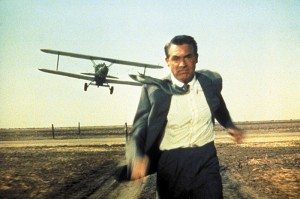

Over the next two months, Film Forum is showing the complete films of both Alfred Hitchcock and Francois Truffaut. In honor of this pairing, we will preview the Hitchcock films using insights from the directors’ own conversations in Hitchcock/Truffaut, Truffaut’s landmark book of interviews.
Film Forum’s “Complete Hitchcock” series kicks off today with an undisputed classic, “North by Northwest,” starring Cary Grant as square advertising executive Roger O Thornhill. The story revolves around mistaken identity, a trope Hitchcock returned to again and again, except in this film, the man Thornhill is mistaken for never existed in the first place. Enemy spies believe that Thornhill is “George Kaplan,” a supposed U.S. spy invented as a cover. Thornhill is abducted, then forcibly intoxicated and, after Hitchcock’s second best drunk driving scene (after “Notorious”), is arrested for DUI and grand theft auto. Attempting to clear his name, he tries to track down the real Kaplan, only to be framed for murder in the middle of the United Nations. Thornhill flees the city, first to Chicago and then to Mt. Rushmore, trying to evade capture and clear his name.
Many find the plot circuitous and confusing. Cary Grant himself complained during shooting that “We’ve already done a third of the picture and I still can’t make head or tail of it.” But Hitchcock isn’t really concerned with the plausibility of the plot, which mainly serves to set up the film’s fantastic set pieces: the United Nations murder, running from the crop duster, hanging from Mt. Rushmore.
The United Nations scene looks so accurate that many think Hitchcock was able to shoot on location, but he reveals that they were denied permission and he resorted to some independent filmmaking tactics to get his shots. A concealed camera in the back of a truck captured Thornhill’s entrance from the street and because they were not allowed inside, an incognito Hitchcock accompanied a still photographer inside and took photos that allowed them to reconstruct the building in a studio.
Much of the directors’ conversation about the film centers on its most famous sequence, Cary Grant in the cornfield running from the murderous crop duster. Truffaut points out that the scene is almost totally gratuitous in terms of the story and could never have been devised by a screenwriter, only a director, and the two both delight in the scene’s absurd incongruity. The plane chase itself is preceded by a long, silent sequence that establishes the setting, which Hitchcock explains is “not dealing with time, but with space. The length of the shots was to indicate the various distances that a man had to run for cover and, more than that, to show that there was no cover to run to.”
Truffaut contrasts this slow, deliberate style with other directors, who might have chosen to portray the scene in an accelerated, subjective manner, but Hitchcock claims that he needed to portray it objectively to show the danger of the fast moving plane. According to Hitchcock, the wide, empty cornfield was chosen as the setting because it was the polar opposite of a claustrophobic city alleyway, which he thought of as the cliché of where a man is set up to be killed.
This weekend is your chance to relive this classic scene on the big screen. “North by Northwest” is showing this Friday, Saturday, and Sunday at Film Forum.